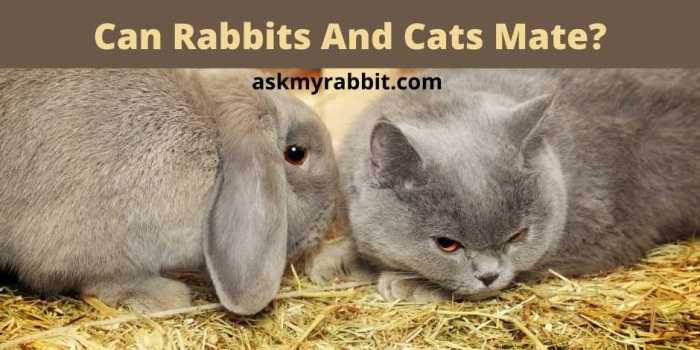The world of animal reproduction is filled with fascinating intricacies and complexities. One question that has sparked curiosity and debate among animal enthusiasts is whether cats and rabbits, two beloved and distinct species, can engage in successful interspecies mating. In this comprehensive exploration, we delve into the scientific realities and evolutionary considerations that govern the compatibility of these two species, unraveling the mysteries surrounding their reproductive capabilities.
As we embark on this journey, we will examine the fundamental biological differences between cats and rabbits, exploring the genetic barriers that prevent successful interbreeding. We will dissect their reproductive anatomies, highlighting the physical incompatibilities that make cross-species mating impossible.
By delving into their natural mating behaviors, we will uncover the stark contrasts in their courtship rituals and mating processes, further solidifying the reproductive isolation between these two species.
Species Compatibility

Interspecies mating between cats and rabbits is biologically impossible due to fundamental differences in their genetic makeup and reproductive systems.
Cats and rabbits belong to distinct taxonomic orders, with cats being members of the order Carnivora and rabbits belonging to the order Lagomorpha. These orders represent deep evolutionary divergences, resulting in significant genetic and physiological differences between the two species.
Genetic Barriers
The genetic material of cats and rabbits is incompatible for successful interspecies mating. Each species possesses a unique set of chromosomes, the structures that carry genetic information. Cats have 38 chromosomes, while rabbits have 44. This difference in chromosome number alone prevents the formation of viable offspring.
Even if chromosome compatibility existed, the genetic code itself differs significantly between cats and rabbits. The DNA sequences that determine the development and characteristics of an organism are distinct for each species. The genetic incompatibility between cats and rabbits would result in developmental abnormalities and non-viable offspring.
Hybrid Misconceptions
A common misconception is that cats and rabbits can mate and produce hybrids. However, this is a biological impossibility.
Hybrids are offspring resulting from the mating of two different species. For hybridization to occur, the genetic material of the two species must be compatible enough to produce viable offspring. Cats and rabbits belong to different orders (Carnivora and Lagomorpha, respectively) and have vastly different genetic makeup.
Chromosomal Differences
One of the main reasons why cats and rabbits cannot produce hybrids is due to their significant chromosomal differences. Cats have 38 chromosomes, while rabbits have 44. This difference in chromosome number makes it impossible for the two species to produce viable offspring.
Genetic Incompatibility
Even if the chromosomal difference could be overcome, the genetic material of cats and rabbits is too dissimilar for successful hybridization. The genes of the two species are not compatible, and any attempt at fertilization would likely result in non-viable embryos or offspring with severe genetic abnormalities.
Evolutionary Considerations
The reproductive isolation between cats and rabbits is a result of millions of years of evolutionary pressures. Natural selection has played a crucial role in preventing interspecies mating, ensuring the preservation of each species’ distinct genetic identity.
Natural Selection
Natural selection favors individuals with traits that enhance their survival and reproductive success in a particular environment. In the case of cats and rabbits, the reproductive isolation between these species has been driven by a combination of factors, including:
- Different reproductive strategies: Cats and rabbits have vastly different reproductive strategies. Cats are solitary hunters that typically mate during specific times of the year, while rabbits are social animals that can breed throughout the year.
- Physical barriers: The physical differences between cats and rabbits, such as their size, body shape, and reproductive anatomy, make it difficult for them to mate successfully.
- Behavioral differences: Cats and rabbits have distinct mating behaviors and courtship rituals. These differences prevent them from recognizing each other as potential mates.
As a result of these evolutionary pressures, cats and rabbits have evolved to be reproductively isolated, preventing the formation of viable hybrid offspring and maintaining the genetic integrity of each species.
Summary
Throughout this discourse, we have delved into the scientific evidence and evolutionary pressures that have shaped the reproductive isolation between cats and rabbits. Our exploration has revealed the fundamental biological differences, genetic barriers, and physical incompatibilities that render interspecies mating between these two species impossible.
We have also dispelled the common misconception of hybrid offspring, providing a clear understanding of the scientific reasons behind this reproductive divide. As we conclude, we can confidently assert that cats and rabbits remain distinct species with their own unique reproductive capabilities, and the notion of their interbreeding remains a fascinating but scientifically unfounded concept.
Frequently Asked Questions
Can cats and rabbits produce offspring?
No, cats and rabbits cannot produce offspring due to fundamental genetic and biological differences.
What are the genetic barriers that prevent interspecies mating?
Cats and rabbits have different numbers of chromosomes, making successful fertilization and embryo development impossible.
Why are the reproductive anatomies of cats and rabbits incompatible?
The physical structures and sizes of their reproductive organs are significantly different, preventing successful mating.
What is the evolutionary significance of reproductive isolation between cats and rabbits?
Reproductive isolation has allowed both species to maintain their distinct genetic identities and adapt to their respective environments.